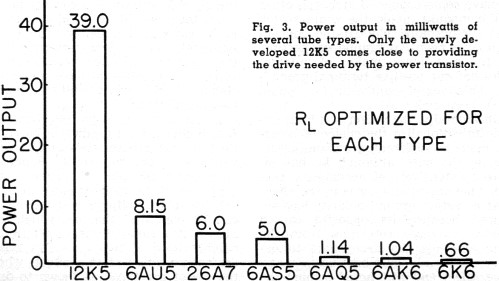
|
|
Graph from the January 1957 Radio News article, as relayed by RF Cafe, showing how poorly standard, "high voltage" power tubes work at a plate voltage of 12 compared to the special 12K5 space-charge tetrode. |
Even though thermionic vacuum tubes have been obsolete (for small-signal [non-power-generating] roles) for nearly half a century, they're fun and instructional to play and work with for electronics/RF hobby purposes. They are also quite readily available from multiple sources, beginning with Ebay. It's arguably easier, and maybe cheaper, to obtain such vacuum tubes than discontinued transistor and integrated circuits, mainly—so think I—because small-signal vacuum tubes aren't used in almost anything useful that's still in service from their heyday. In contrast to this, because end-of-lifing solid-state devices commonly imperils equipment still in service, the cost of obsolete solid-state spares may soar.
Tube-availability prospects are all the brighter (and cheaper) for hobbyists and experimenters willing to shake free of the thrall of using exactly yesterday's tubes exactly as yesterday used them. This page highlights such tubes and such practices.
Identical Tubes with Different Heater Voltages
You can use a 3BE6 instead of a 6BE6—really. A 9GV8 will work just as well as a 6GV8—really! Use a transformer that produces the next-higher standard heater voltage (usually 6.3, 12.6, and 25.2) at sufficient current, and make up the difference by seriesing/paralleling tubes, and/or with voltage-dropping resistors capable of dissipating at least twice the necessary power each. There's magic (and cheaper tube prices on Ebay and at your local hamfest) in building a three-stage transmitter with a 3AU6-16GK6-17JN6 lineup, and it will work just as well as one built using the exact-equivalent "standard" tubes everybody else thinks they need.
Low-Plate-Voltage Automotive Tubes
Before transistors were of much value for RF, even AM-broadcast-band, use, they were plenty good for audio. As a result of this, in the mid-1950s the vacuum-tube industry designed and manufactured a line of tubes specialized for operation at heater and plate/screen voltages on the order of 12.6, plus and minus the difference between that voltage and automotive-battery-system maximum and minimum. These tubes were used in hybrid designs that were all-tube up through a special space-charge driver tube that provided the tens of milliwatts of audio necessary to drive AF-power-amplifier transistors to speaker-level output. Long-term members of that odd stratum of radio hobbyists who find themselves simultaneously interested in tube experimentation while being averse to "high" voltages (pretty much anything above 45 volts, it seems) inevitably find their way to experimenting with this class of tubes . . . for awhile.
I say "for awhile" because, compared to tubes of standard design intended for operation at higher voltages, low-plate/screen-voltage tubes are significantly poorer performers. Wrote Vern Chambers, W1JEQ, in his "Something New in High-Frequency Mobile Converters," QST, 1956, pages 16–21:
As might so very well be expected, there is one small fly in the ointment as far as the new tubes are concerned. They do overload at signal levels considerably below that handled with ease by conventional high-voltage tubes. However, in actual practice, we have run across only one or two ham-band signals that caused the converter to "fold up." All other cases of overload have been effectively treated merely by detuning the input circuit.
Tubes in this class include the 12AD6 and 12GA6 (frequency converters); 12BL6, 12DZ6 and 12EA6 (pentode RF/IF amplifiers); 12AE6 (triode/diodes); and 12K5 (space-charge power tetrode). Jeff Duntemann's "Low-Voltage Tubes" page provides an extensive list of these types. From the January 1957 issue of Radio and Television News, RF Cafe relays "Low Plate-Potential Tubes," by C. E. Atkins of Tung-Sol, which provides an overview of the drivers and challenges involved in developing low-voltage tube designs that could be reliably manufactured while providing useful performance and stable characteristics.

|
|
Graph from the January 1957 Radio News article, as relayed by RF Cafe, showing how poorly standard, "high voltage" power tubes work at a plate voltage of 12 compared to the special 12K5 space-charge tetrode. |
9DX Tubes (and Other Tubes "No One Uses")
To be continued...
| Revised November 24, 2016 CE. | Copyright ©2016 by David Newkirk (DavidNewkirk@gmail.com). All rights reserved. |
| home |